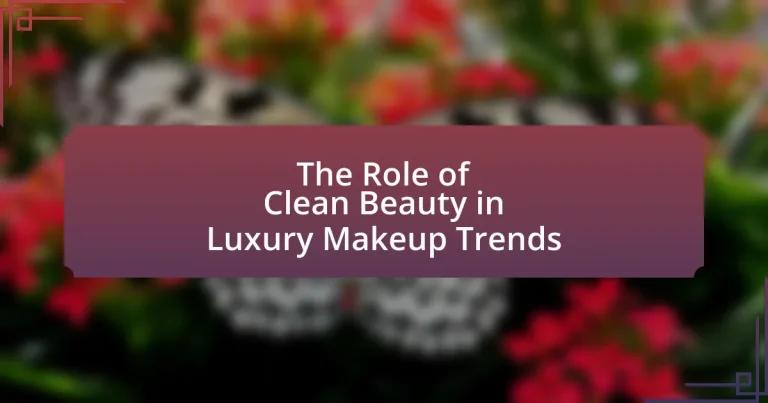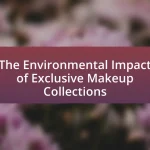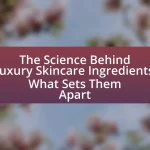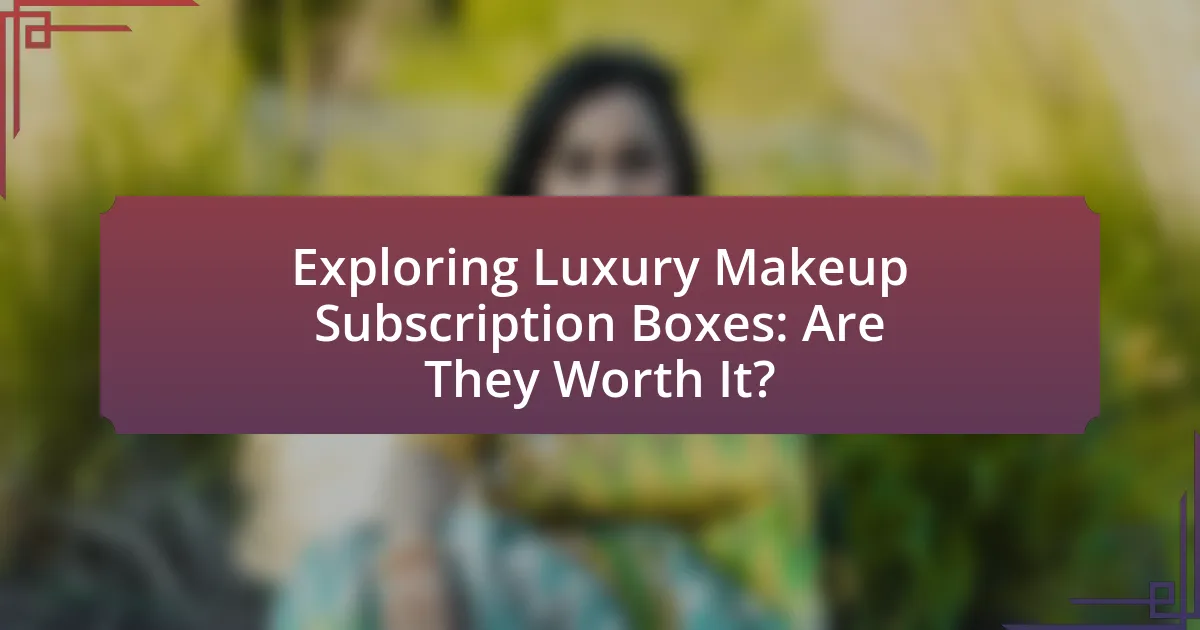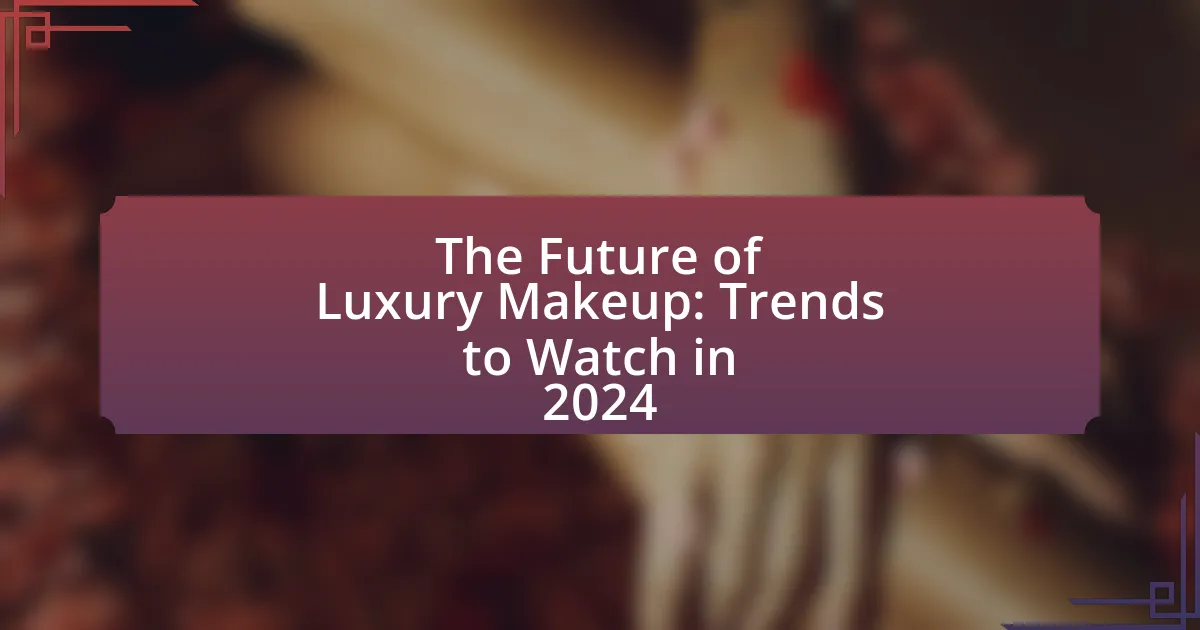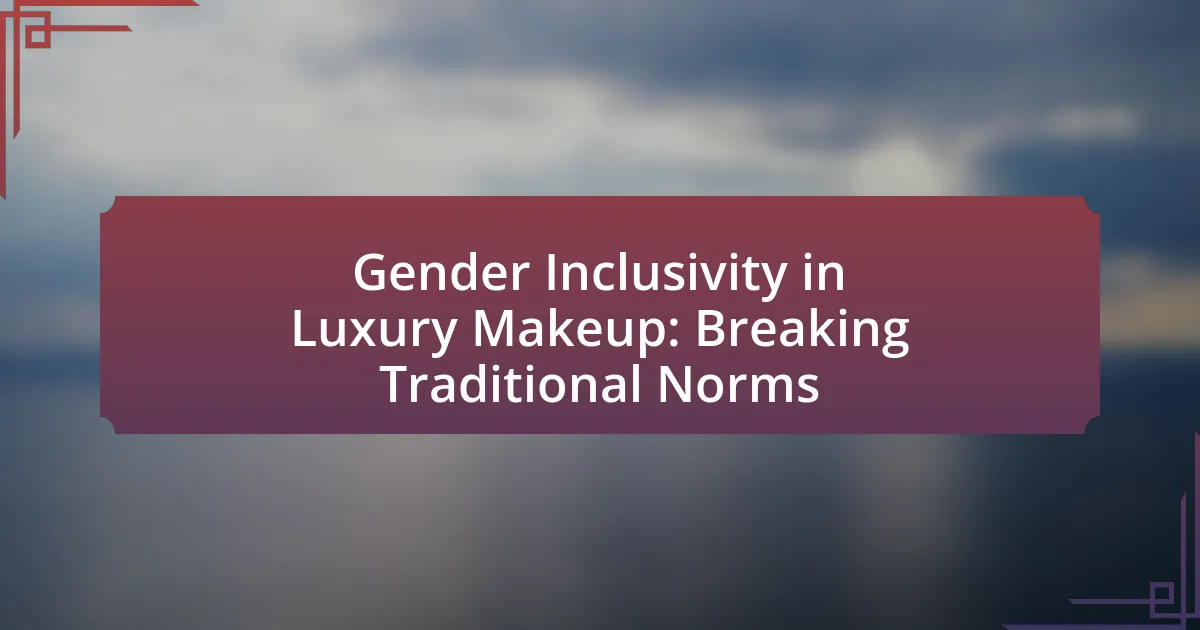Clean beauty is increasingly influencing luxury makeup trends by emphasizing non-toxic, environmentally friendly ingredients while ensuring high-quality performance. This article explores the evolution of clean beauty definitions within the luxury sector, highlighting the shift towards sustainability, ethical sourcing, and transparency in ingredient formulations. It examines the key ingredients considered clean, the differences between clean and traditional luxury makeup standards, and the consumer trends driving demand for clean beauty products. Additionally, the article discusses the challenges luxury brands face in adopting clean beauty practices, the role of influencers in promoting these trends, and future expectations for clean beauty innovations in the luxury market.
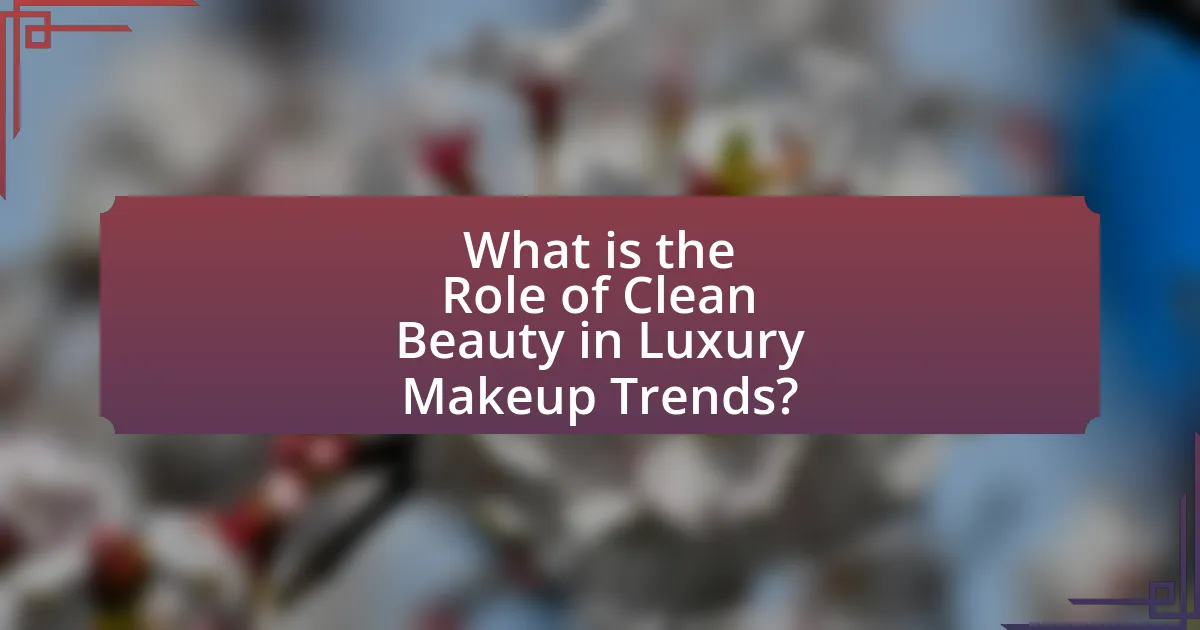
What is the Role of Clean Beauty in Luxury Makeup Trends?
Clean beauty plays a significant role in luxury makeup trends by prioritizing non-toxic, environmentally friendly ingredients while maintaining high-quality performance. This shift reflects consumer demand for transparency and sustainability, with a growing number of luxury brands incorporating clean formulations to appeal to health-conscious consumers. For instance, a report by Grand View Research indicates that the global clean beauty market is expected to reach $22 billion by 2024, highlighting the increasing importance of clean beauty in the luxury segment. As a result, luxury makeup brands are innovating to create products that not only enhance beauty but also align with ethical and health standards, thereby redefining luxury in the cosmetics industry.
How has the definition of clean beauty evolved in the luxury makeup sector?
The definition of clean beauty in the luxury makeup sector has evolved to encompass not only the absence of harmful ingredients but also a commitment to sustainability and ethical sourcing. Initially, clean beauty focused primarily on eliminating toxic chemicals, but it has now expanded to include environmentally friendly packaging, cruelty-free practices, and transparency in ingredient sourcing. For instance, luxury brands like Dior and Gucci have introduced clean beauty lines that prioritize natural ingredients and sustainable practices, reflecting a broader consumer demand for products that align with personal values and environmental responsibility. This shift is supported by market research indicating that 70% of consumers are willing to pay more for sustainable products, highlighting the growing importance of clean beauty in luxury makeup trends.
What ingredients are considered clean in luxury makeup products?
Clean ingredients in luxury makeup products typically include natural oils, plant extracts, and minerals, while avoiding harmful substances like parabens, sulfates, and synthetic fragrances. For instance, ingredients such as jojoba oil, shea butter, and aloe vera are often used for their nourishing properties, while titanium dioxide and zinc oxide serve as safe mineral-based sunscreens. The clean beauty movement emphasizes transparency and sustainability, leading luxury brands to adopt formulations that prioritize skin health and environmental responsibility. This shift is supported by consumer demand for safer, non-toxic products, reflecting a broader trend towards wellness in the beauty industry.
How do clean beauty standards differ from traditional luxury makeup standards?
Clean beauty standards prioritize non-toxic, environmentally friendly ingredients, while traditional luxury makeup standards often focus on high-performance formulations that may include synthetic chemicals. Clean beauty brands typically avoid harmful substances such as parabens, sulfates, and phthalates, emphasizing transparency in ingredient sourcing and production processes. In contrast, traditional luxury makeup may prioritize aesthetic appeal and brand prestige over ingredient safety, often using synthetic additives to enhance product performance and longevity. This distinction reflects a broader consumer shift towards health-conscious and sustainable choices in the beauty industry.
Why is clean beauty gaining popularity among luxury consumers?
Clean beauty is gaining popularity among luxury consumers due to a growing demand for transparency and sustainability in personal care products. Luxury consumers increasingly prioritize products that are free from harmful chemicals and are ethically sourced, reflecting a broader societal shift towards health-conscious and environmentally friendly choices. According to a 2021 report by McKinsey & Company, 67% of consumers consider sustainability when making luxury purchases, indicating that clean beauty aligns with their values. This trend is further supported by the rise of social media influencers advocating for clean beauty brands, which enhances consumer awareness and interest in these products.
What consumer trends are driving the demand for clean beauty in luxury makeup?
The demand for clean beauty in luxury makeup is primarily driven by consumer preferences for sustainability, health consciousness, and transparency. Consumers increasingly seek products that are environmentally friendly, with a significant 70% of millennials indicating a preference for brands that demonstrate sustainability practices. Additionally, the rise in awareness about harmful ingredients has led consumers to prioritize products that are free from toxins and allergens, reflecting a broader trend towards health and wellness. Transparency in ingredient sourcing and formulation is also crucial, as 94% of consumers are more likely to trust brands that provide clear information about their products. These trends collectively underscore a shift towards ethical consumption in the luxury beauty sector.
How does consumer awareness of ingredients impact luxury makeup purchases?
Consumer awareness of ingredients significantly influences luxury makeup purchases by driving demand for transparency and clean formulations. As consumers become more informed about the potential harmful effects of certain chemicals, they increasingly prefer products that feature natural, organic, or non-toxic ingredients. A study by the NPD Group found that 60% of consumers consider ingredient safety a key factor in their purchasing decisions, particularly in the luxury segment where brand reputation and quality are paramount. This shift towards ingredient-conscious buying behavior compels luxury brands to reformulate products and highlight ingredient integrity, ultimately impacting sales and brand loyalty.
What are the key benefits of integrating clean beauty into luxury makeup trends?
Integrating clean beauty into luxury makeup trends offers several key benefits, including enhanced consumer trust, improved skin health, and alignment with sustainability values. Consumers increasingly prioritize transparency and ingredient safety, leading luxury brands to adopt clean formulations that foster trust and loyalty. Research indicates that 70% of consumers are more likely to purchase products labeled as clean, reflecting a significant market shift towards health-conscious choices. Additionally, clean beauty products often utilize natural ingredients that can improve skin health, reducing irritation and promoting a more radiant complexion. Finally, aligning with sustainability values resonates with a growing demographic that seeks eco-friendly options, thereby enhancing brand reputation and market competitiveness.
How does clean beauty enhance the overall luxury makeup experience?
Clean beauty enhances the overall luxury makeup experience by prioritizing high-quality, non-toxic ingredients that promote skin health while delivering premium performance. This approach aligns with the growing consumer demand for transparency and sustainability in beauty products, which is increasingly becoming a hallmark of luxury brands. For instance, a study by the Environmental Working Group found that consumers are willing to pay more for products that are free from harmful chemicals, indicating that clean beauty not only meets safety standards but also elevates the perceived value of luxury makeup. Additionally, brands that adopt clean beauty practices often emphasize ethical sourcing and eco-friendly packaging, further enhancing the luxury experience by appealing to the values of modern consumers.
What environmental benefits are associated with clean beauty in luxury makeup?
Clean beauty in luxury makeup offers significant environmental benefits, primarily through the use of sustainable ingredients and eco-friendly packaging. Sustainable ingredients reduce the reliance on harmful chemicals, which can pollute ecosystems and harm wildlife. For instance, brands often utilize plant-based, biodegradable components that minimize environmental impact compared to synthetic alternatives. Additionally, eco-friendly packaging, such as recyclable or compostable materials, decreases plastic waste, which is a major contributor to ocean pollution. According to a report by the Ellen MacArthur Foundation, transitioning to sustainable packaging could reduce plastic waste by 80% by 2040. Thus, clean beauty practices in luxury makeup not only promote healthier products for consumers but also contribute to the preservation of the environment.
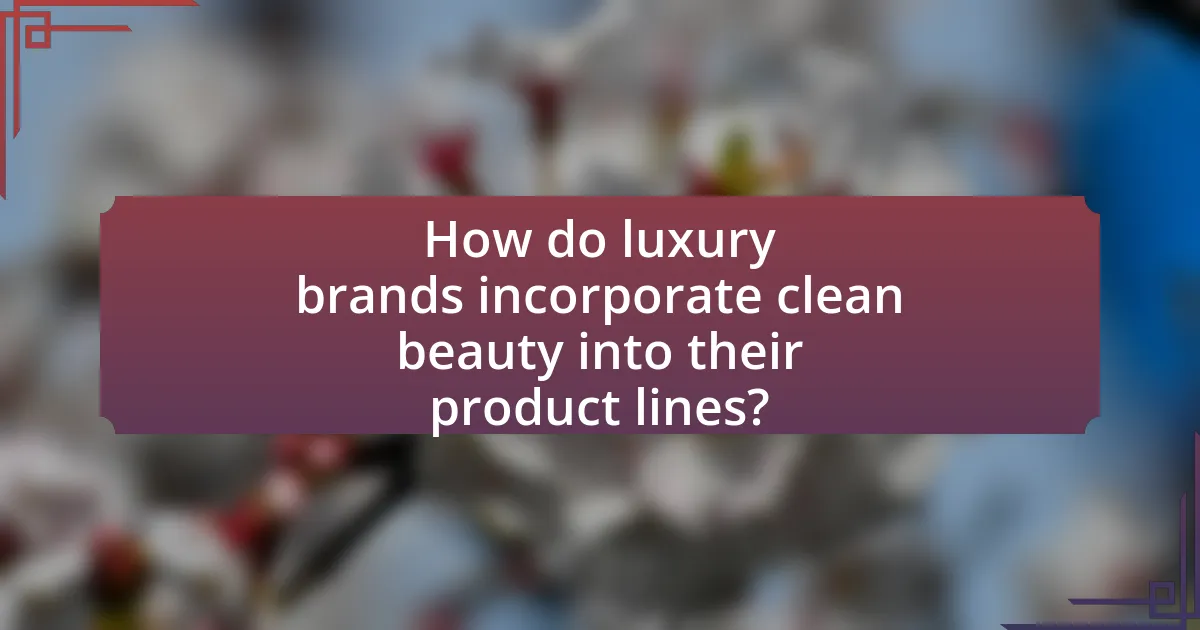
How do luxury brands incorporate clean beauty into their product lines?
Luxury brands incorporate clean beauty into their product lines by formulating products with non-toxic, sustainable ingredients while ensuring high performance and luxury appeal. For instance, brands like Dior and Gucci have introduced skincare and makeup lines that emphasize natural ingredients, eco-friendly packaging, and cruelty-free practices, aligning with consumer demand for transparency and sustainability. According to a report by McKinsey & Company, the clean beauty market is projected to grow significantly, indicating that luxury brands are adapting to this trend to maintain relevance and attract environmentally conscious consumers.
What strategies are luxury brands using to promote clean beauty?
Luxury brands are promoting clean beauty through transparency in ingredient sourcing, sustainable packaging, and collaborations with eco-conscious influencers. These brands emphasize the use of natural, non-toxic ingredients and often provide detailed information about their formulations to build consumer trust. For instance, brands like Gucci Beauty and Dior have launched products that highlight their commitment to sustainability, using recyclable materials and reducing carbon footprints. Additionally, luxury brands are leveraging social media campaigns featuring eco-conscious influencers to reach a broader audience, thereby aligning their products with the values of environmentally aware consumers. This strategic approach not only enhances brand image but also caters to the growing demand for ethical beauty products.
How do marketing campaigns highlight clean beauty in luxury makeup?
Marketing campaigns highlight clean beauty in luxury makeup by emphasizing the use of natural, non-toxic ingredients and sustainable practices. These campaigns often showcase product formulations that are free from harmful chemicals, appealing to consumers’ growing demand for transparency and ethical sourcing. For instance, brands like Fenty Beauty and Ilia Beauty leverage social media and influencer partnerships to communicate their commitment to clean beauty, often featuring certifications such as cruelty-free and vegan labels. This strategy not only aligns with consumer values but also positions luxury makeup as both effective and responsible, tapping into the increasing trend of conscious consumerism in the beauty industry.
What role do influencers play in promoting clean beauty trends in luxury makeup?
Influencers play a crucial role in promoting clean beauty trends in luxury makeup by leveraging their platforms to educate and engage consumers about sustainable and non-toxic products. They often showcase luxury brands that prioritize clean ingredients, thereby influencing their followers’ purchasing decisions. For instance, a study by the Digital Marketing Institute found that 49% of consumers rely on influencer recommendations when making beauty purchases, highlighting the significant impact influencers have on consumer behavior in the luxury segment.
What challenges do luxury brands face when adopting clean beauty practices?
Luxury brands face significant challenges when adopting clean beauty practices, primarily due to the high cost of sourcing sustainable ingredients and the need for reformulating existing products. These brands often rely on premium materials that may not align with clean beauty standards, leading to increased production costs and potential price hikes for consumers. Additionally, luxury brands must navigate consumer skepticism regarding the efficacy of clean products compared to traditional formulations, as well as the challenge of maintaining brand prestige while shifting to a more transparent and ethical approach. According to a report by McKinsey & Company, 67% of consumers are concerned about sustainability, yet only 25% trust brands to deliver on their clean beauty promises, highlighting the trust gap that luxury brands must overcome.
How do sourcing and formulation challenges affect clean beauty in luxury makeup?
Sourcing and formulation challenges significantly hinder the advancement of clean beauty in luxury makeup by limiting the availability of high-quality, sustainable ingredients. Luxury makeup brands often rely on rare botanicals and eco-friendly materials, which can be difficult to source due to environmental regulations, supply chain disruptions, and competition for these resources. For instance, the demand for organic ingredients has surged, yet only a fraction of the global agricultural land is dedicated to organic farming, leading to scarcity. Additionally, formulation challenges arise when trying to create effective products without harmful chemicals, as many traditional formulations rely on synthetic compounds for stability and performance. This can result in higher production costs and longer development times, ultimately affecting the brand’s ability to innovate and meet consumer expectations for both luxury and sustainability.
What regulatory hurdles must luxury brands navigate in the clean beauty space?
Luxury brands in the clean beauty space must navigate stringent regulations regarding ingredient safety, labeling, and marketing claims. These regulations are enforced by agencies such as the FDA in the United States and the European Commission in the EU, which require thorough safety assessments and compliance with specific standards for natural and organic claims. For instance, the EU’s Cosmetics Regulation mandates that all cosmetic products undergo safety assessments before being marketed, and any claims made must be substantiated with scientific evidence. Additionally, luxury brands face challenges in ensuring transparency in their supply chains to meet consumer demand for ethical sourcing and sustainability, which is increasingly scrutinized by regulatory bodies.
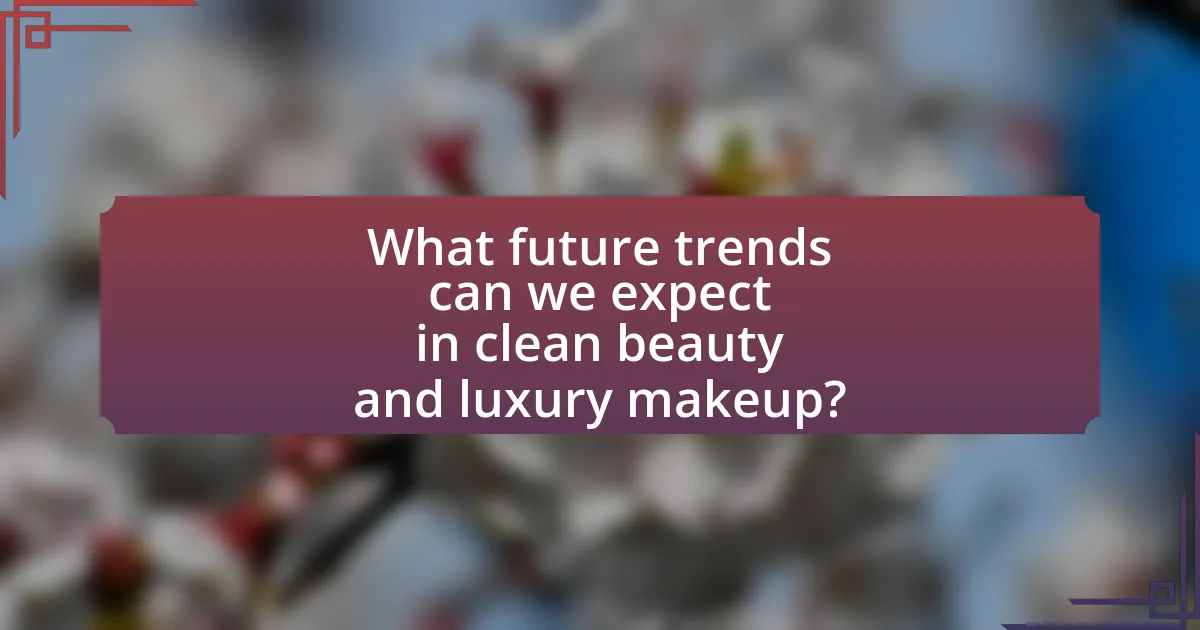
What future trends can we expect in clean beauty and luxury makeup?
Future trends in clean beauty and luxury makeup will increasingly focus on sustainability, transparency, and innovative formulations. Brands are expected to prioritize eco-friendly packaging and ethically sourced ingredients, responding to consumer demand for environmentally responsible products. According to a report by Grand View Research, the global clean beauty market is projected to reach $22 billion by 2024, indicating a significant shift towards products that are both luxurious and clean. Additionally, advancements in biotechnology are likely to lead to more effective, natural ingredients that enhance product performance while maintaining clean standards. This trend aligns with the growing consumer awareness around health and wellness, driving luxury brands to adopt cleaner practices without compromising on quality or efficacy.
How will technological advancements influence clean beauty in luxury makeup?
Technological advancements will significantly enhance clean beauty in luxury makeup by enabling the development of innovative formulations and sustainable practices. For instance, advancements in biotechnology allow brands to create high-performance ingredients derived from natural sources, reducing reliance on synthetic chemicals. Additionally, improvements in packaging technology facilitate the use of recyclable and biodegradable materials, aligning with the eco-conscious values of luxury consumers. Research indicates that 70% of consumers are willing to pay more for sustainable products, highlighting the market demand for such innovations. Thus, technology not only drives product efficacy but also supports the sustainability goals of luxury makeup brands.
What innovations are emerging in clean beauty formulations for luxury products?
Innovations in clean beauty formulations for luxury products include the use of bio-based ingredients, advanced sustainable packaging, and personalized skincare solutions. Bio-based ingredients, derived from natural sources, enhance product efficacy while minimizing environmental impact. For instance, brands are increasingly incorporating plant-derived actives that offer high performance comparable to traditional synthetic ingredients. Advanced sustainable packaging innovations, such as biodegradable materials and refillable systems, are being adopted to reduce waste and promote circularity in luxury beauty. Additionally, personalized skincare solutions leverage technology, such as AI and skin analysis tools, to create tailored formulations that meet individual consumer needs, enhancing the luxury experience. These trends reflect a growing consumer demand for transparency, sustainability, and efficacy in luxury beauty products.
How might consumer preferences shape the future of clean beauty in luxury makeup?
Consumer preferences will significantly shape the future of clean beauty in luxury makeup by driving brands to prioritize transparency, sustainability, and ethical sourcing. As consumers increasingly demand products free from harmful chemicals and environmentally friendly packaging, luxury makeup brands are adapting their formulations and marketing strategies to align with these values. For instance, a 2021 survey by McKinsey & Company found that 67% of consumers consider sustainability when making luxury purchases, indicating a clear shift towards clean beauty. This trend compels luxury brands to innovate and reformulate their products to meet consumer expectations, ensuring they remain competitive in a rapidly evolving market.
What practical tips can consumers follow when choosing clean beauty luxury makeup?
Consumers should prioritize ingredient transparency when choosing clean beauty luxury makeup. This means examining product labels for harmful chemicals and opting for brands that disclose their ingredient sourcing and formulation processes. Research indicates that consumers are increasingly aware of the potential health risks associated with synthetic ingredients, leading to a demand for products that utilize natural and organic components. Additionally, consumers should look for certifications such as “Cruelty-Free” or “Vegan,” which can provide assurance regarding ethical practices. Brands that invest in sustainable packaging and environmentally friendly practices also align with the clean beauty ethos, further enhancing their appeal in the luxury market.
How can consumers identify truly clean beauty products in luxury makeup lines?
Consumers can identify truly clean beauty products in luxury makeup lines by examining ingredient lists for harmful substances and looking for certifications from reputable organizations. Clean beauty products typically avoid ingredients like parabens, sulfates, and synthetic fragrances, which are often linked to health concerns. Additionally, certifications such as the EWG Verified mark or Leaping Bunny certification indicate that a product meets specific safety and ethical standards. Research shows that the clean beauty market is growing, with a 2021 report from Grand View Research indicating a projected CAGR of 9.7% from 2021 to 2028, reflecting increased consumer demand for transparency and safety in beauty products.
What are the best practices for transitioning to clean beauty in luxury makeup routines?
The best practices for transitioning to clean beauty in luxury makeup routines include researching and selecting brands that prioritize clean ingredients, gradually replacing conventional products with clean alternatives, and focusing on transparency regarding ingredient sourcing and formulation. Research indicates that consumers are increasingly seeking products free from harmful chemicals, with a 2021 survey by Statista showing that 60% of beauty consumers prefer brands that are transparent about their ingredients. Gradual replacement allows for a smoother transition, helping individuals assess how their skin reacts to new formulations. Additionally, prioritizing brands that provide clear information about their commitment to sustainability and ethical practices reinforces the transition to clean beauty.
